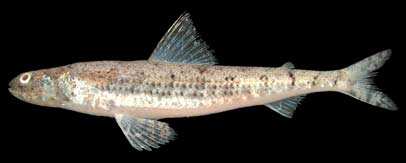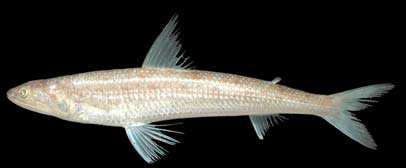SYNODONTIDAE
Lizardfishes
By Seishi Kimura
 Saurida nebulosa |
 Saurida tumbil |
 Synodus dermatogenys |
 Synodus variegatus |
|
Small to medium-sized marine fishes; maximum size about 70 cm, commonly 20-40 cm. Body slender, cylindrical, and moderately elongated. Mouth large; hind tip of upper jaw extending well beyond hind margin of eye; a single supramaxilla small or absent; numerous needle-like teeth on jaws and palatines; branchiostegal rays 12-18. No spinous fin rays; dorsal fin located about the center of body, 9-15 rays; anal fin posterior to dorsal fin base, 8-17 rays; caudal fin forked, 19 principal rays; pelvic fins close together, 8-9 rays; adipose fin present above anal fin. Cycloid scales present at least on the posterior half of body and along lateral line. Color: body usually brown or reddish with variable markings. Peritoneum either pale with several black spots, or black. Similar families occurring in the area. Synodontidae is distinguished from the following similar families in having a cylindrical or somewhat compressed head with a large mouth (hind tip extending beyond eye), 0-1 supramaxilla, 12-18 branchiostegals, 9-15 dorsal-fin rays, and adipose fin. Aulopidae: two supramaxillae present; hind tip of upper jaw not or slightly extending beyond hind margin of eye. Bathysauridae: head depressed conspicuously; branchiostegal rays 8-13; adipose fin present or absent; pelvicfin rays 8. Chlorophthamlidae: a single elongate supramaxilla present; hind tip of upper jaw not extending beyond center of eye. Remarks. Occurring in tropical to temperate marine and estuarine areas, usually found on rocky, coral, sandy, or muddy bottoms in shallow waters. Feed on small fishes and crustaceans. |

|
|